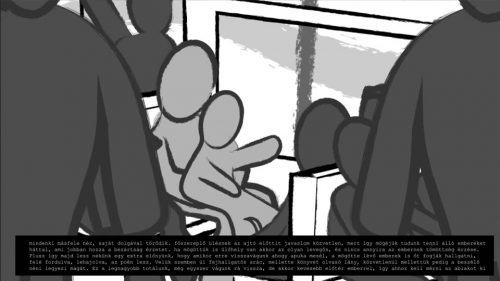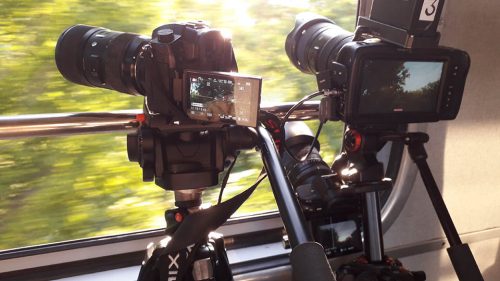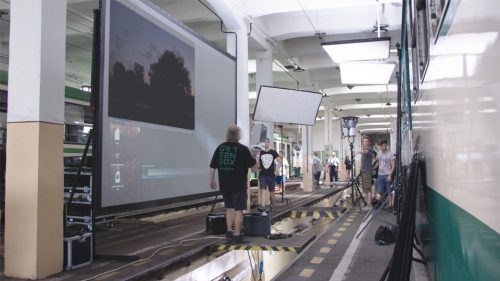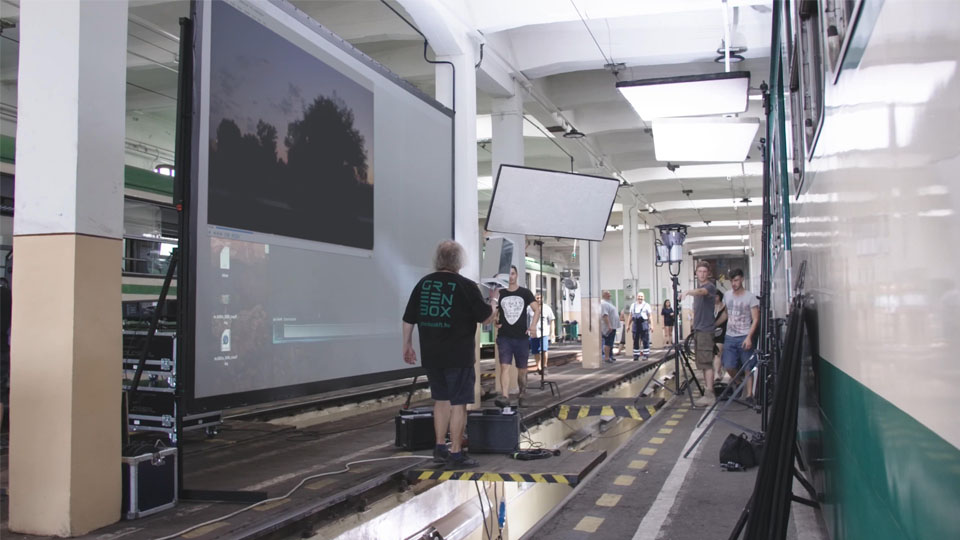 Since the possibility of subsequent modification was reduced to almost zero with the projected background, it was very important to be aware of the inner operation of the commercial cut by cut. We at the Mimicry animation studio do not really believe in the usefulness of a storyboard, because during shootings we often experience that what looks good in static images, fails during movement. That’s why we created a moving, animated storyboard, a kind of animatik, which already showed the finished commercial with sound, talking and rudimentary animation.
Since the possibility of subsequent modification was reduced to almost zero with the projected background, it was very important to be aware of the inner operation of the commercial cut by cut. We at the Mimicry animation studio do not really believe in the usefulness of a storyboard, because during shootings we often experience that what looks good in static images, fails during movement. That’s why we created a moving, animated storyboard, a kind of animatik, which already showed the finished commercial with sound, talking and rudimentary animation.
The animation was also very good because it was possible to present it to the client and discuss the questionable points. In this way, with just a few revision rounds, we arrived to a cartoon that showed us very precisely the direction, angle, cut and length of the necessary cuts. Based on this, a very precise list of demands for the background projection was compiled.
 So we got together the week before the shoot and spent the sunset every night on the section of HÉV in question. Unfortunately, the rails were picked up that time for most of the section, which greatly reduced the potential background options. We also installed three cameras in the window of the HÉV, and we recorded all the angles in question traveling around with them. At the end of the week, we selected the most beautiful ones, and with the help of some digital animation, we created endless loops. In the videos, we covered the cut with digital drifting trees, so wherever the background material was going, when the cameras started rolling, we knew it would always be perfect.
So we got together the week before the shoot and spent the sunset every night on the section of HÉV in question. Unfortunately, the rails were picked up that time for most of the section, which greatly reduced the potential background options. We also installed three cameras in the window of the HÉV, and we recorded all the angles in question traveling around with them. At the end of the week, we selected the most beautiful ones, and with the help of some digital animation, we created endless loops. In the videos, we covered the cut with digital drifting trees, so wherever the background material was going, when the cameras started rolling, we knew it would always be perfect.
On the day of the shoot, it turned out that the warehouse where the HÉV train is located is not as dark as it should be, so instead of projecting a very long surface with several projectors, we created a much stronger image by concentrating the light of our two large industrial projectors on a single narrow slice. This was already bright enough to be seen properly from inside the train.
 Although through the windows the HÉV train looked as if it was moving, the realism we wanted was still a long way off. We resorted to several small tricks to make the viewer believe that he is sitting in a moving wagon. First of all, we hid elements on the edges of the image that start to swing helplessly from movement, for example the hanging buckle of a backpack. This was then continuously moved slowly by one of the extras, creating the illusion of movement. In addition, to illustrate the light breaking in between the running trees, we installed rotating mirrors along the length of the train, which caused streams of light running along the entire length of the wagon.
Although through the windows the HÉV train looked as if it was moving, the realism we wanted was still a long way off. We resorted to several small tricks to make the viewer believe that he is sitting in a moving wagon. First of all, we hid elements on the edges of the image that start to swing helplessly from movement, for example the hanging buckle of a backpack. This was then continuously moved slowly by one of the extras, creating the illusion of movement. In addition, to illustrate the light breaking in between the running trees, we installed rotating mirrors along the length of the train, which caused streams of light running along the entire length of the wagon.
Solving the fog was a particular difficulty: although we prepared with many different tools, including the most exotic glycerine solutions, the reflectors caused the temperature to rise so high that nothing remained on the glass. Finally, a significant part of the steam required digital assistance.


You must be logged in to post a comment.